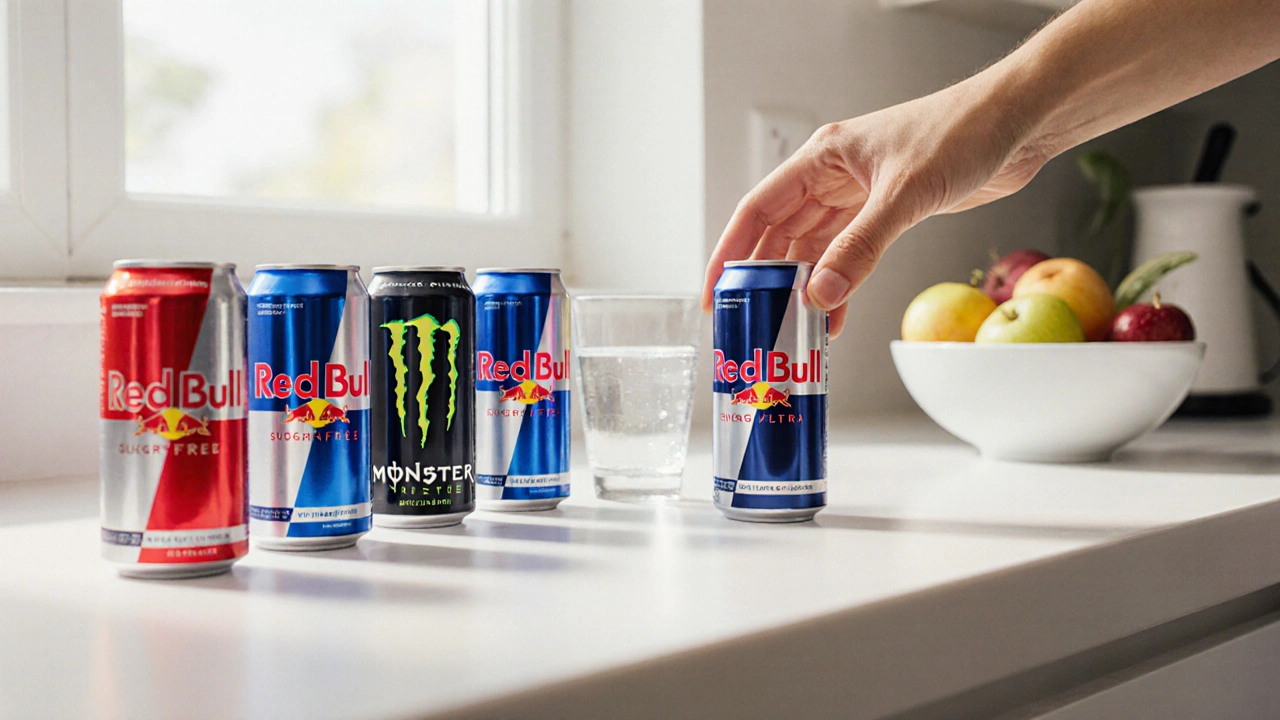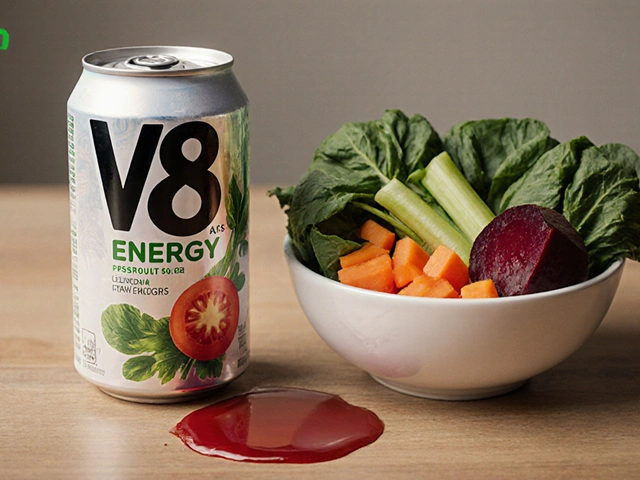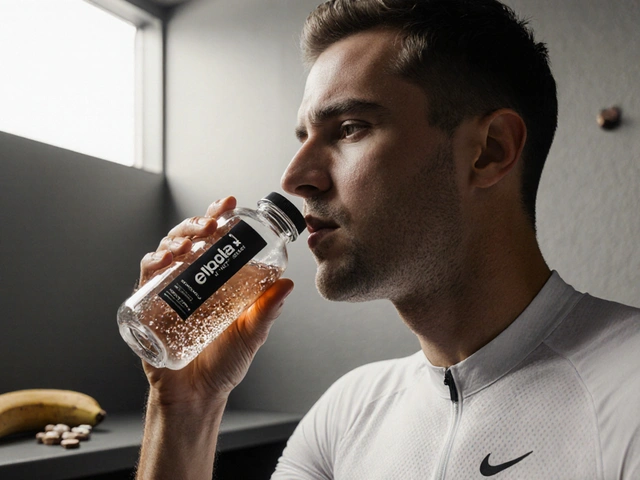Fast Stomach Slimming with Low‑Calorie Energy Drinks - Quick Guide

Caffeine Intake Calculator
Caffeine Intake Calculator
Calculate your daily caffeine intake from energy drinks and other sources. Keep total caffeine below 400mg for safe consumption while using low-calorie energy drinks for stomach slimming.
Results
Your total daily caffeine intake: 0 mg
ℹ️ Enter your intake to see recommendations
Want a flatter belly without starving yourself? The trick isn’t a magic pill - it’s a mix of smarter drink choices, a calorie deficit, and a few everyday habits that speed up your metabolism. Below you’ll find a step‑by‑step plan that uses low‑calorie energy drinks to kick‑start fat loss, plus the diet and movement tweaks that keep the results coming.
Quick Take: 5‑Minute Action Plan
- Swap sugary sodas for a low‑calorie energy drink (choose one with < 5g sugar).
- Calculate your daily calorie goal and aim for a 300-500kcal deficit.
- Drink 1-2 cans before workouts to boost performance.
- Add 20‑30g of protein to every meal to preserve muscle.
- Move your body for at least 30minutes, 5days a week.
Follow these five steps and you’ll start seeing a slimmer waist in as little as two weeks.
What’s Really Behind Stomach Fat?
Before you reach for any drink, it helps to know why belly fat sticks around. Visceral fat sits deep around your organs and is more metabolically active than subcutaneous fat. It thrives when insulin spikes frequently - a common result of high‑sugar beverages and irregular meals.
Key players in belly‑fat dynamics:
- Insulin - the hormone that shuttles glucose into cells. Constant spikes push the body into fat‑storage mode.
- Cortisol - stress hormone that encourages abdominal fat when chronically elevated.
- Metabolic rate - how many calories you burn at rest. Higher rates = more calories burned, even while sleeping.
By controlling insulin spikes and giving your metabolism a gentle push, you can turn the belly‑fat furnace on.
How Low‑Calorie Energy Drinks Can Help
Low‑calorie energy drinks are not just caffeine pills; they’re formulated to deliver a clean energy boost without the sugar load that sabotages insulin control.
Low‑calorie energy drink is a carbonated (or still) beverage that contains caffeine, B‑vitamins, electrolytes, and zero‑ or low‑calorie sweeteners such as sucralose, erythritol, or stevia. It provides the alertness of coffee but with far fewer calories, typically under 10kcal per 250ml serving.
Three mechanisms make them belly‑friendly:
- Caffeine‑induced thermogenesis: Caffeine raises resting metabolic rate by ~3‑5% and can increase fat oxidation during exercise.
- Appetite moderation: The bitter taste of caffeine, combined with a modest amount of artificial sweetener, can suppress short‑term cravings.
- Improved workout performance: With more energy, you tend to exercise harder, burning more calories per session.
When you pair a low‑calorie energy drink with a modest calorie deficit, the combined effect can accelerate belly‑fat loss without the crash of high‑sugar drinks.

Choosing the Right Drink - Comparison Table
| Brand | Caffeine (mg) | Calories (per 250ml) | Sweetener | Key Add‑ons |
|---|---|---|---|---|
| Red Bull Sugarfree | 80 | 5 | Aspartame, Acesulfame‑K | Vitamin B6, B12 |
| Monster Zero Ultra | 140 | 10 | Sucralose, Acesulfame‑K | Ginseng, Taurine |
| Bang Energy | 300 | 0 | Sucralose, Acesulfame‑K | CoQ10, BCAAs |
Pick a drink that matches your caffeine tolerance. If you’re new to caffeine, start with Red Bull Sugarfree (80mg) and work upward. For seasoned athletes who need a heavy pre‑workout punch, Bang’s 300mg can be effective-just keep total daily caffeine under 400mg.
Pairing Drinks with a Calorie‑Deficit Diet
Even the most potent energy drink won’t melt belly fat if you’re overeating. Use a simple calculator (like the Mifflin‑St Jeor equation) to estimate your Total Daily Energy Expenditure (TDEE). Subtract 300-500kcal to set your daily target.
Sample macro split that works well with caffeine‑boosted training:
- Protein: 30% (≈1.2g perkg body weight)
- Carbs: 35% (focus on complex carbs, fiber‑rich veggies)
- Fats: 35% (mostly unsaturated sources)
Why protein matters: caffeine can increase cortisol, which can break down muscle if protein is insufficient. A solid protein intake preserves lean mass while you lose fat.
Sample 7‑Day Stomach‑Slimming Routine
Below is a realistic week‑long plan that incorporates two low‑calorie energy drinks a day-one in the morning, one pre‑workout. Adjust portions to fit your calorie goal.
- Day1 - Monday
- Breakfast: Greek yogurt + berries + 1 tbsp chia seeds.
- Drink: 250ml Red Bull Sugarfree.
- Lunch: Grilled chicken salad with olive oil vinaigrette.
- Pre‑workout: 250ml Monster Zero Ultra (30min before 30‑min HIIT).
- Dinner: Baked salmon, quinoa, steamed broccoli.
- Day2 - Tuesday
- Breakfast: Scrambled eggs + spinach + whole‑grain toast.
- Drink: 250ml Red Bull Sugarfree.
- Lunch: Turkey wrap with avocado.
- Afternoon walk (30min) - no drink needed.
- Dinner: Stir‑fried tofu, brown rice, mixed veggies.
- Day3 - Wednesday
- Breakfast: Protein shake (whey) + a small banana.
- Drink: 250ml Bang Energy (if you tolerate high caffeine).
- Lunch: Lentil soup + side salad.
- Pre‑workout: 250ml Monster Zero Ultra (before 45‑min strength session).
- Dinner: Grilled shrimp, cauliflower mash.
- Day4 - Thursday
- Breakfast: Overnight oats with almond milk and nuts.
- Drink: Red Bull Sugarfree.
- Lunch: Quinoa bowl with black beans, corn, salsa.
- Evening yoga (45min) - no caffeine.
- Dinner: Baked cod, roasted sweet potatoes.
- Day5 - Friday
- Breakfast: Cottage cheese + pineapple chunks.
- Drink: Monster Zero Ultra.
- Lunch: Chicken Caesar salad (light dressing).
- Pre‑workout: Bang Energy (if you want a strong finish).
- Dinner: Turkey meatballs, zucchini noodles.
- Day6 - Saturday
- Breakfast: Smoothie (spinach, protein powder, frozen berries).
- Drink: Red Bull Sugarfree.
- Brunch: Whole‑grain pancakes with a drizzle of sugar‑free syrup.
- Afternoon hike (60min) - stay hydrated with water.
- Dinner: Grilled steak, asparagus.
- Day7 - Sunday
- Breakfast: Avocado toast with poached egg.
- Drink: Monster Zero Ultra (optional, if you need a lift).
- Lunch: Chickpea salad with feta.
- Active rest: Light stretching, walking.
- Dinner: Vegetable stir‑fry with tempeh.
Throughout the week, aim for at least 2L of water daily. Hydration helps the kidneys flush out caffeine metabolites and keeps you feeling full.
Common Pitfalls & How to Avoid Them
- Over‑relying on caffeine: Too much caffeine can raise cortisol and disrupt sleep, both of which stall fat loss. Keep total caffeine under 400mg per day.
- Skipping meals: Skipping breakfast to “save calories” often leads to overeating later. Use the energy drink as a breakfast enhancer, not a meal substitute.
- Choosing sugary variants: Some energy drinks still hide 10g+ of sugar. Always read the nutrition label; zero‑sugar is key for insulin control.
- Neglecting resistance training: Cardio burns calories, but resistance work preserves muscle, which keeps your resting metabolism high.
- Ignoring sleep: Sleep deprivation spikes cortisol and messes with hunger hormones (ghrelin, leptin). Aim for 7-9hours nightly.
Quick Checklist - Slim Your Stomach in 7 Days
- ✅ Replace any sugary soda with a low‑calorie energy drink.
- ✅ Calculate TDEE, set a 300-500kcal deficit.
- ✅ Hit 1‑2 servings of the drink per day (max 400mg caffeine).
- ✅ Include protein (≥1.2g/kg) at every meal.
- ✅ Move for 30minutes, 5days (mix cardio + strength).
- ✅ Sleep 7‑9hours, stay hydrated.
Frequently Asked Questions
Can I drink a low‑calorie energy drink on an empty stomach?
Yes, but only a small serving (around 250ml). The caffeine will give a quick energy boost, but pairing it with a protein‑rich snack prevents a blood‑sugar dip.
Is artificial sweetener safe for weight loss?
Current research shows non‑nutritive sweeteners like sucralose or stevia don’t add calories and don’t raise insulin. They’re fine for most adults, but some people report cravings-test what works for you.
How many cans per day is too many?
Keep total caffeine under 400mg. That usually means no more than two cans of Monster Zero Ultra (140mg each) or one Bang (300mg) plus a smaller Red Bull Sugarfree.
Will this plan work without any exercise?
Exercise isn’t optional for fastest belly‑fat loss. Caffeine can boost metabolism a bit, but cardio and resistance training provide the calorie burn and muscle preservation needed for a visible waist.
Can I use a regular coffee instead?
Sure, coffee gives similar caffeine without sweeteners. Just watch the added sugar or cream, which can increase calories and affect insulin.






Comments (11)
King Medoo
10 Oct 2025
Switching to low‑calorie energy drinks can feel like a harmless shortcut, but the ethical implications run deeper than the calorie count. When manufacturers market these beverages as “fat‑burning miracles,” they exploit a cultural obsession with quick fixes, steering vulnerable consumers toward dependence on stimulants. The caffeine surge may momentarily boost metabolism, yet it also masks the underlying habit of using food as a reward, which perpetuates an unhealthy relationship with eating. Moreover, the artificial sweeteners-often touted as safe-have been linked in some studies to altered gut microbiota, potentially undermining long‑term metabolic health. From a moral standpoint, promoting a drink that replaces real nutrition with synthetic compounds feels like a betrayal of public trust. Consumers deserve transparent labeling that highlights not just calories but also the physiological cost of chronic stimulant exposure. The “quick‑fix” narrative also distracts from evidence‑based strategies such as balanced macronutrient distribution and progressive resistance training, which yield sustainable results. If we keep glorifying these drinks, we reinforce a capitalist cycle that profits from our insecurities while offering fleeting satisfaction. Ethically, we should question who benefits from the surge in sales-large corporations, not the individual seeking health. Social media influencers amplify this message, often without disclosing sponsorships, further muddling the line between advice and advertisement. A responsible approach would involve educating users about caffeine tolerance, potential adrenal strain, and the importance of sleep hygiene. It is also crucial to emphasize that a calorie deficit achieved through wholesome foods is far more nourishing than one achieved by empty‑calorie stimulants. For those who still opt for these drinks, moderation is key: no more than one or two cans per day, never replacing meals, and always pairing with adequate protein. Tracking total caffeine intake helps avoid surpassing the 400 mg safety ceiling, protecting heart health and reducing anxiety spikes. In sum, the moral compass points toward informed choice, critical scrutiny of marketing, and a balanced lifestyle over seductive shortcuts. 🌱💪🚀
Rae Blackburn
11 Oct 2025
They hide the truth behind shiny cans and the government monitors every sip 😱
LeVar Trotter
11 Oct 2025
The protocol outlined in the guide aligns well with established principles of energy balance and substrate utilization. By incorporating a modest caffeine dose, you harness a thermogenic effect that can increase resting metabolic rate by approximately 3‑5 %. Concurrently, the protein‑centric macronutrient distribution supports muscle protein synthesis, preserving lean tissue during caloric deficit. The inclusion of resistance‑training sessions capitalizes on the anabolic window created by caffeine‑induced catecholamine release. Moreover, the emphasis on low‑glycemic carbohydrates mitigates insulin spikes, curbing de novo lipogenesis. From a physiological standpoint, the synergy of ergogenic aids and structured nutrition optimizes substrate partitioning. It is advisable to monitor plasma cortisol levels if the caffeine load exceeds individual tolerance, as chronic elevation may impede fat oxidation. Overall, the regimen offers a comprehensive, evidence‑based framework for sustainable adipose reduction.
Seraphina Nero
12 Oct 2025
I love how the plan mixes protein and movement for steady progress.
Megan Ellaby
13 Oct 2025
the snack timing could be a lil tighter maybe add a whey shake right after the workout it’ll keep the muscle pump going and stop the cravings
E Jones
13 Oct 2025
The push for low‑calorie energy drinks is not a benevolent health initiative but a calculated maneuver by the shadow food conglomerates. They have swapped sugar for synthetic sweeteners, yet the underlying intent remains the same: to keep consumers in a perpetual state of dependency on stimulants. Behind the glossy packaging lies a network of lobbying groups that obscure the true metabolic cost of chronic caffeine exposure. These entities fund think‑tanks that churn out “research” praising thermogenesis while conveniently ignoring the hormonal disruptions they cause. The data streams fed to the public are filtered through corporate algorithms designed to amplify the allure of quick‑fix solutions. In the same breath, regulatory agencies are pressured to relax labeling standards, allowing vague terms like “zero‑sugar” to mask potential gut‑flora impacts. The hidden agenda extends to the digital realm where influencers, often paid under the table, brainwash their followers with success stories that rarely disclose the accompanying cortisol spikes. Meanwhile, the real casualties are the millions who experience insomnia, anxiety, and a distorted appetite regulation without ever suspecting the culprit. The fact that some drinks contain up to 300 mg of caffeine per can is a deliberate escalation meant to foster tolerance and push users toward larger doses. As tolerance builds, the body’s adrenal glands become strained, creating a feedback loop that forces even higher consumption to achieve the same energy surge. This cycle mirrors the classic opiate model, substituting chemicals that are legal yet equally insidious. The strategic placement of these beverages in gyms, schools, and office vending machines cements their role as a ubiquitous performance enhancer. Yet the real performance enhancer is the capitalist apparatus that profits from our perpetual fatigue and desire for shortcuts. The solution, if any, lies in reclaiming agency over our nutritional choices and demanding transparent, science‑backed information. Only when the public awakens to the orchestrated narrative will the market be forced to prioritize genuine wellness over profit. 🌐⚠️🚨
Addison Smart
14 Oct 2025
While the narrative around hidden agendas can feel compelling, it is equally important to recognize that many consumers genuinely benefit from the modest thermogenic boost these drinks provide. A balanced perspective acknowledges both the potential metabolic advantages and the legitimate concerns regarding excessive caffeine intake. Implementing a structured monitoring system-tracking total daily milligrams and timing consumption relative to sleep-can mitigate many of the highlighted risks. Moreover, integrating whole‑food sources of caffeine such as green tea offers a comparable stimulant effect with added antioxidants. Encouraging transparent labeling empowers individuals to make informed decisions without resorting to fear‑based rhetoric. Ultimately, personal responsibility combined with corporate accountability creates a more sustainable path toward belly‑fat reduction. By fostering open dialogue, we can shift the conversation from conspiratorial suspicion to collaborative health optimization. Let’s channel the energy from these debates into actionable lifestyle changes that benefit everyone.
David Smith
15 Oct 2025
Wow this guide reads like a late‑night infomercial promising miracles. The promises of a slimmer waist in two weeks are pure hype. If you’re looking for a quick fix, grab a can and hope for the best. But real results need patience, not just flashy slogans.
Lissa Veldhuis
16 Oct 2025
Honestly the whole low‑calorie energy drink craze is just another marketing gimmick. People think slapping caffeine on a sugar‑free label makes it a health food. It’s nothing more than a sugar‑free sugar boost that tricks the brain. If you’re serious about slimming, ditch the cans and focus on real nutrition. Anything else is a shortcut for the lazy.
Michael Jones
16 Oct 2025
Push past the cravings, stay consistent, and the waistline will shrink as your effort compounds.
Abert Canada
17 Oct 2025
I see where you’re coming from and agree that real nutrition matters, but a well‑timed low‑calorie drink can still serve as a handy pre‑workout boost when used responsibly.